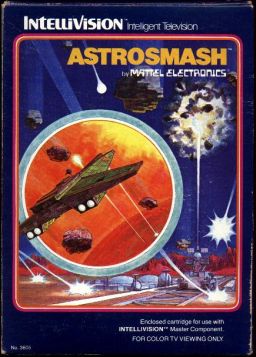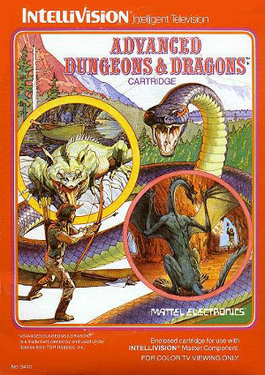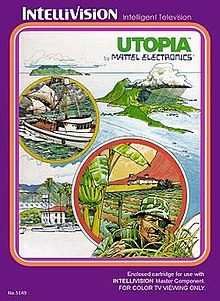
The Intellivision is a home video game console released by Mattel Electronics in 1979. The name is a portmanteau of "intelligent television". Development began in 1977, the same year as the launch of its main competitor, the Atari 2600. In 1984, Mattel sold its video game assets to a former Mattel Electronics executive and investors, eventually becoming INTV Corporation. Game development ran from 1978 to 1990 when the Intellivision was discontinued. From 1980 to 1983, more than 3 million consoles were sold.
Real-time strategy (RTS) is a subgenre of strategy video games that do not progress incrementally in turns, but allow all players to play simultaneously, in "real time". By contrast, in turn-based strategy (TBS) games, players take turns to play. The term "real-time strategy" was coined by Brett Sperry to market Dune II in the early 1990s.

A role-playing video game, commonly referred to as a role-playing game (RPG) or computer role-playing game (CRPG), is a video game genre where the player controls the actions of a character immersed in some well-defined world, usually involving some form of character development by way of recording statistics. Many role-playing video games have origins in tabletop role-playing games and use much of the same terminology, settings and game mechanics. Other major similarities with pen-and-paper games include developed story-telling and narrative elements, player character development, complexity, as well as replay value and immersion. The electronic medium removes the necessity for a gamemaster and increases combat resolution speed. RPGs have evolved from simple text-based console-window games into visually rich 3D experiences.

Tommy Tallarico is an American video game music composer, musician, sound designer, television personality, live show creative director and producer. He and his company, Tommy Tallarico Studios, worked on several video games since the 1990s. He co-hosted the television shows Electric Playground and Reviews on the Run from 1997 until 2006. In 2002, he created Video Games Live (VGL), a global video game music orchestra.

A home video game console is a video game console that is designed to be connected to a display device, such as a television, and an external power source as to play video games. Home consoles are generally less powerful and customizable than personal computers, designed to have advanced graphics abilities but limited memory and storage space to keep the units affordable. While initial consoles were dedicated units with only a few games fixed into the electronic circuits of the system, most consoles since support the use of swappable game media, either through game cartridges, optical discs, or through digital distribution to internal storage.

A city-building game, or town-building game, is a genre of simulation video game where players act as the overall planner and leader of a city or town, looking down on it from above, and being responsible for its growth and management strategy. Players choose building placement and city management features such as salaries and work priorities, and the city develops accordingly.
1980 saw the release of a number of games with influential concepts, including Pac-Man, Battlezone, Crazy Climber, Mystery House, Missile Command, Phoenix, Rally-X, Space Panic, Stratovox, Zork, Adventure, and Olympic Decathlon. The year's highest-grossing video game was Namco's arcade game Pac-Man, while the best-selling home system was Nintendo's Game & Watch. The Atari VCS also grew in popularity with a port of Space Invaders and support from new third-party developer Activision.
The following outline is provided as an overview of and topical guide to video games:

Frog Bog is a 1982 video game by Mattel Electronics for the Intellivision. An Atari 2600 conversion was released later that year as Frogs and Flies. In both games, each player controls a frog sitting on a lily pad, attempting to eat more flies than the other. Frog Bog is similar to the 1978 Sega-Gremlin arcade game Frogs.

An action role-playing game is a subgenre of video games that combines core elements from both the action game and role-playing genre.

Astrosmash is a fixed shooter video game for the Intellivision console, designed by John Sohl, and released by Mattel Electronics in 1981. The player uses a laser cannon to destroy falling meteors, bombs, and other targets.

Intellivision World Series Major League Baseball is a baseball video game (1983) designed by Don Daglow and Eddie Dombrower, and published by Mattel for the Intellivision Entertainment Computer System. IWSB was one of the first sports video games to use multiple camera angles and present a three-dimensional perspective. It was also the first statistics-based baseball simulation game on a video game console; all prior console baseball games were arcade-style recreations of the sport.
In the history of video games, the second generation era refers to computer and video games, video game consoles, and handheld video game consoles available from 1976 to 1982 Notable platforms of the second generation include the Fairchild Channel F, Atari 2600, Intellivision, Odyssey 2, and ColecoVision. The generation began in November 1976 with the release of the Fairchild Channel F. This was followed by the Atari 2600 in 1977, Magnavox Odyssey² in 1978, Intellivision in 1980 and then the Emerson Arcadia 2001, ColecoVision, Atari 5200, and Vectrex, all in 1982. By the end of the era, there were over 15 different consoles. It coincided with, and was partly fuelled by, the golden age of arcade video games. This peak era of popularity and innovation for the medium resulted in many games for second generation home consoles being ports of arcade games. Space Invaders, the first "killer app" arcade game to be ported, was released in 1980 for the Atari 2600, though earlier Atari-published arcade games were ported to the 2600 previously. Coleco packaged Nintendo's Donkey Kong with the ColecoVision when it was released in August 1982.

Advanced Dungeons & Dragons is an Intellivision game; it was one of the first Advanced Dungeons & Dragons games to be licensed by TSR, Inc. It was later retitled to Advanced Dungeons & Dragons: Cloudy Mountain to distinguish it from the sequel, Advanced Dungeons & Dragons: Treasure of Tarmin. It is the first Intellivision cartridge to use more than 4K of ROM.
Construction and management simulation (CMS), sometimes also called management sim or building sim, is a subgenre of simulation game in which players build, expand or manage fictional communities or projects with limited resources. Strategy video games sometimes incorporate CMS aspects into their game economy, as players must manage resources while expanding their project. Pure CMS games differ from strategy games, however, in that "the player's goal is not to defeat an enemy, but to build something within the context of an ongoing process." Games in this category are sometimes also called "management games".

Skiing is a sports video game produced by Mattel and released for its Intellivision video game system in 1980. Up to six players compete individually on either a downhill or slalom course to see who can complete the course the fastest. For the game's initial release, Mattel obtained a license from the U. S. Ski Team and used its name and logo in the game's box art. In 1988, INTV Corporation released an enhanced version of the game entitled Mountain Madness: Super Pro Skiing.

Beauty & the Beast is a platform game written by Wendell Brown for the Intellivision and released on December 31, 1982 by Imagic. It is a single-player game with a concept similar to Nintendo's Donkey Kong.

The Intellivision Amico is a home video game console that is being developed and marketed by Intellivision Entertainment. It was originally slated to be released in October 2020, but repeated delays followed, leaving the console without a release date.













